Google Nexus 5 Review
by Brian Klug on December 5, 2013 8:00 AM EST- Posted in
- Smartphones
- LG
- Android
- Mobile
- Snapdragon 800
- Android 4.4
- Nexus 5
Cellular
The Nexus 4 was lambasted for not including LTE, even though it shipped with Band 4 LTE inadvertently enabled before an update disabled it. What it did have was DC-HSPA+ and receive diversity that its predecessor didn’t. With Nexus 5, Google has added LTE and done nearly the same two-device USA and rest of world LTE band combination split it did with the new Nexus 7.
|
LG-D820 (North America) |
LG-D821 (Rest of World) |
|
| Baseband | MSM8974 (Category 4 LTE - 150 Mbps DL/50 Mbps UL) | |
| Transceiver | WTR1605L | |
| GSM | 850/900/1800/1900 MHz | |
| CDMA2000 | BC: 0/1/10 | - |
| WCDMA | 1/2/4/5/6/8/19 | 1/2/4/5/6/8 |
| LTE | 1/2/4/5/17/19/25/26/41 | 1/3/5/7/8/20 |
The USA Nexus 5 is LG-D820 and includes the necessary LTE bands for AT&T, T-Mobile, and Sprint (yes it’s a tri-band Sprint Spark device), in addition to DC-HSPA+, and CDMA2000. The “rest of world” Nexus 5 is LG-D821 and trades the North America specific LTE bands 4, 17, 19, 25, 26, and 41 for 3, 7, 8 and 20 which make a lot more sense for Europe and EMEA, and of course lacks CDMA2000. I’ve put a table together with the two variants and their band combinations.
The Nexus 5 uses MSM8974 which includes the third generation of Qualcomm’s multimode LTE modem. It’s a Category 4 LTE part, capable of 150 Mbps on the downstream and 50 Mbps on the upstream. That means if you’re lucky enough to be using an operator who has 20 MHz of contiguous spectrum and is running 20 MHz LTE channels, you can realize that full 150 Mbps of downstream. Transceiver is still WTR1605L which obviously is still quite competent, with enough ports for the two LTE configurations Google went with. Nexus 5 goes with the typical pragmatic antenna placement of primary Rx/Tx at the bottom, secondary Rx at the top. There's actually a total of 5 antennas, if we look at the back of the device with the cover off it's easy to pick them out.
What’s interesting about the Nexus 5 is that it’s the second device on the market with one of Qualcomm’s RF360 suite of RF front end components. In this case, that’s the QFE1100 envelope tracker which the Note 3 also included, although interestingly enough the LG G2 includes a QFE1101 APT (average power tracker), a simplified version of the same component.
After display, power amplifiers are probably the second or third largest consumers of power in a mobile device attached to a cellular network. The envelope tracker’s purpose is to increase DC to RF efficiency and correspondingly decrease current consumption and heat generation. The envelope tracker is essentially a DC to DC power supply that creates a supply voltage that tracks the envelope of the transmit signal, providing the correct amount of supply voltage to match instantaneous demand of the power amplifier. It’s impressive that Nexus 5 includes an envelope tracker considering its economical price point.
An interesting consequence of the LG-D820 being a Sprint Spark device is that the Nexus 5 also includes some field test menus. Previous Nexus devices didn’t afford any interesting details beyond what was exposed through the RIL, the Nexus 5 is the first that appeases me with some additional details. You can get to these either by making an activity to it, or there’s also an awesome app with shortcuts already on the market.
Under mobile networks there’s now the ability to change between 2G, 3G, and LTE for the preferred network mode. Up a level there’s a new “mobile plan” shortcut which ostensibly takes you to the provisioning page for whatever operator you’re attached to. Oddly enough this does nothing on T-Mobile, it’d make sense to have this go to T-Mobile’s account status page.
I have no issues with cellular connectivity on the Nexus 5, which I used on AT&T before switching to T-Mobile LTE just fine.
WiFi
Mobile handsets have steadily increased WLAN throughput rates and PHY capabilities each year. It seems that not a generation goes by that we don’t get something more than the generation before it, and the latest handsets include 802.11ac, the new 5 GHz WLAN specification that includes support for 80 MHz wide channels and higher order modulation (256QAM) among other things. Nexus 4 included dual band WiFi (2.4 and 5 GHz) based on Qualcomm’s WCN3660 WLAN combo chip, Nexus 5 adds 802.11ac with the latest Broadcom silicon, BCM4339, the evolution of BCM4335, their first 802.11ac combo. It’s still single stream, which isn’t surprising or a negative, giving it a maximum PHY rate of 433.3 Mbps.
BCM4339 we’ve already seen once in the Note 3, which is an easier to implement derivative of BCM4335 which includes on-chip 2.4 and 5 GHz transmit power amplifiers and receive low noise amplifiers. External front ends are still supported of course if an OEM wants to, though I can’t see why they wouldn’t just opt for a 4335 instead if they’re going that route.
In any case the Nexus 5 has leading edge WLAN/BT with the same feature support as BCM4335, including Bluetooth 4.0 Smart Ready. To test I turned to iPerf to test throughput, same as always.
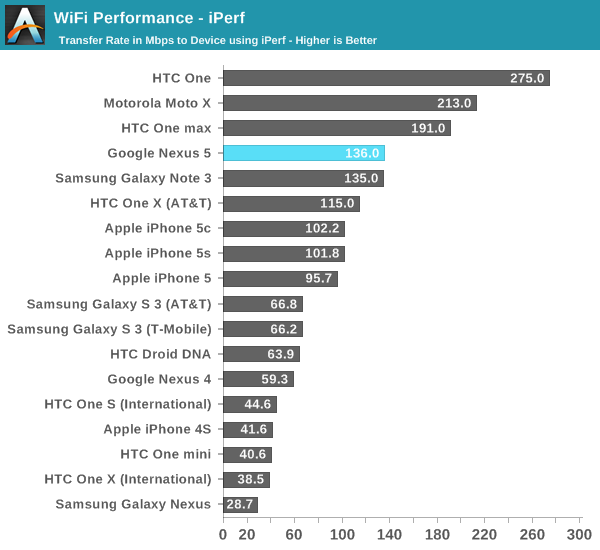
It’s interesting to me that both the Note 3 and Nexus 5 pack the same combo, and end up having just about the same throughput, an average of 135 Mbps when attached with the best MCS, with very brief spikes to just below 300 Mbps. Oddly enough one thing I noticed is that touch input seems to be blocked entirely on the Nexus 5 until iPerf is quit. I’m not sure what’s going on here when the WiFi link is completely saturated, but it seems that touch response becomes very slow. I have no issues with range or connection stability on the Nexus 5, and I’ll also note that the device doesn’t antenna share, but rather has a discrete antenna for WLAN/BT.
GNSS
GNSS (Global Navigation Satellite System) on the Nexus 5 uses the engines and support on MSM8974, in this case GNSS Gen 8B, which is capable of locking and using all three modern constellations in play right now – GPS (USA Navstar), GLONASS (Russian), and Beidou (China). I’ve always been impressed with how quickly Qualcomm’s GNSS obtains a 3D fix from cold start (even though there’s really no such thing as cold start anymore), and it’s obvious that sharing clocks and rough position from the modem dramatically helps. I had no issues with GNSS on the Nexus 5. GNSS also has its own discrete antenna in the top right of the Nexus 5, there’s no antenna sharing going on.
The location services menu in KitKat is changed around considerably as well, with a new icon and menus that now give some breakdown of per-app energy consumption based on how long they hold onto location services. Rather than a complicated menu with discrete checkboxes, the new configuration panel moves to a high accuracy, battery saving, and device only breakdown.
Sound
It’s no secret that the audio subsystem on Android has been the subject of scrutiny and lots of OEM and partner tweaks for a while now. With KitKat, Google adds platform support for audio tunneling to the DSP in the device chipset. Specifically, this means tasks like audio decode (for common codecs like MP3, AAC, and so forth) and output effects (room simulation, spatializer) can be done on the much lower power DSP rather than run on the CPU.
In the case of the Nexus 5, this feature is explicitly used for lower power audio decode, and Google claims it results in 50 percent more audio playback time. I always assumed that the stock Android ports had this ability, but it turns out this was one of those things silicon vendors would add in atop the base platform.
Nexus 5 also implements the latest codec from Qualcomm, WCD9320, the successor to WCD9310 from the previous generation. A lot of people have asked for better line out audio quality comparisons, our Chris Heinonen is working on some awesome audio quality testing with a suite of devices. Of course the reality of audio quality on line out is that it’s contingent on how well the OEM has implemented things, not just what hardware codec is used.
Nexus 5 has two speaker grilles at the bottom, but unsurprisingly only one speaker. The other grille just hides the primary microphone. The secondary microphone is up top on the Nexus 5 which is used for noise cancelation.
I measured speaker sound pressure level on the Nexus 5 the same way I always do for a voice call. Unfortunately my subjective impressions were confirmed – Nexus 5 is quite quiet on speakerphone calls, slightly louder than the LG G2. There’s an odd bimodal behavior on the Nexus 5 as well, with some apps seeming louder than others by a fair margin. I suspect the gains for some of the DSP tunneled audio paths aren’t quite matched to the software decode paths or something, another thing which hopefully will be fixed soon.

Noise cancelation is something I’ve been measuring or trying to get a subjective grasp on for a while now, and I tested the Nexus 5 the same way I have other devices, by placing a call in front of some speakers and increasing the volume while recording the far end of the call. In the case of the Nexus 5, Qualcomm’s Fluence is doing the noise rejection heavy lifting between the primary microphone at bottom and secondary up top
I’m actually very impressed with how well the Nexus 5 performed at rejecting noise using the normal babble distractor track I use. In addition this was a T-Mobile AMR-WB “HD Voice” call between two Nexus 5s, illustrating that the Nexus 5 is indeed in the T-Mobile whitelist for HD Voice.
As an aside, the Nexus 4 oddly enough still hasn’t been green lit for HD Voice on T-Mobile, and given its age probably never will at this point, although the hardware is entirely capable.


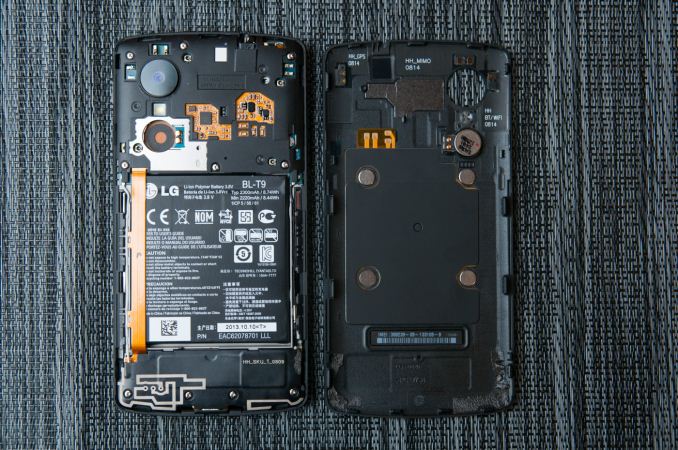
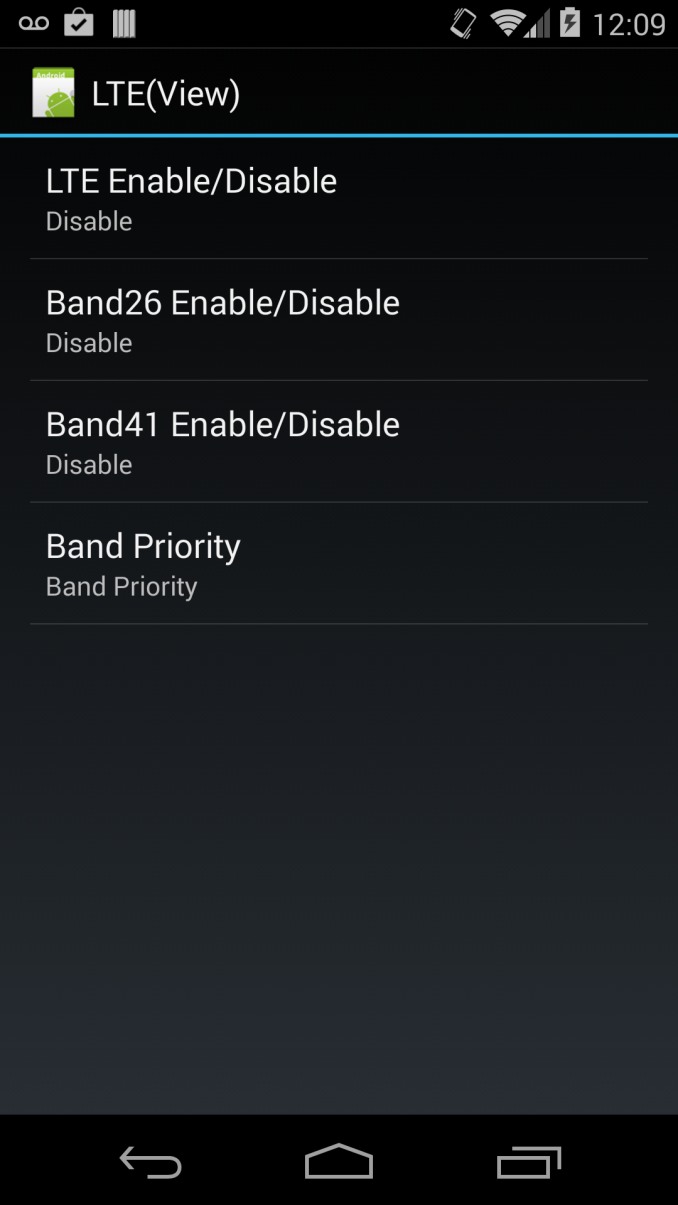
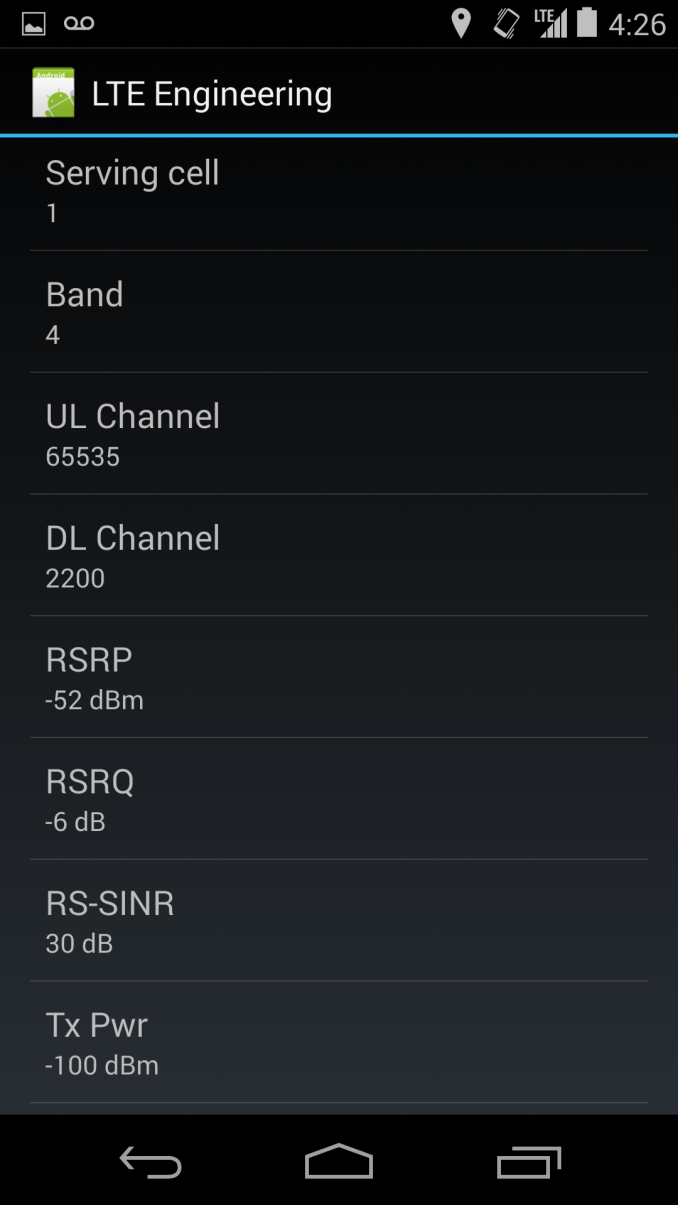
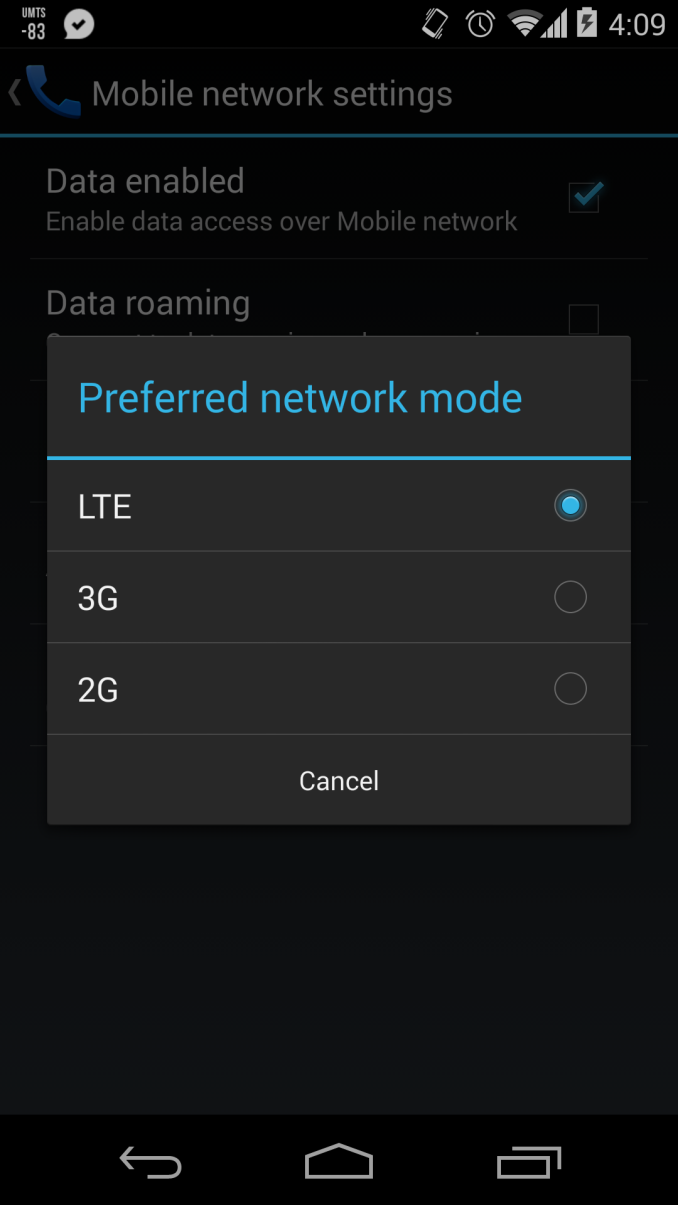
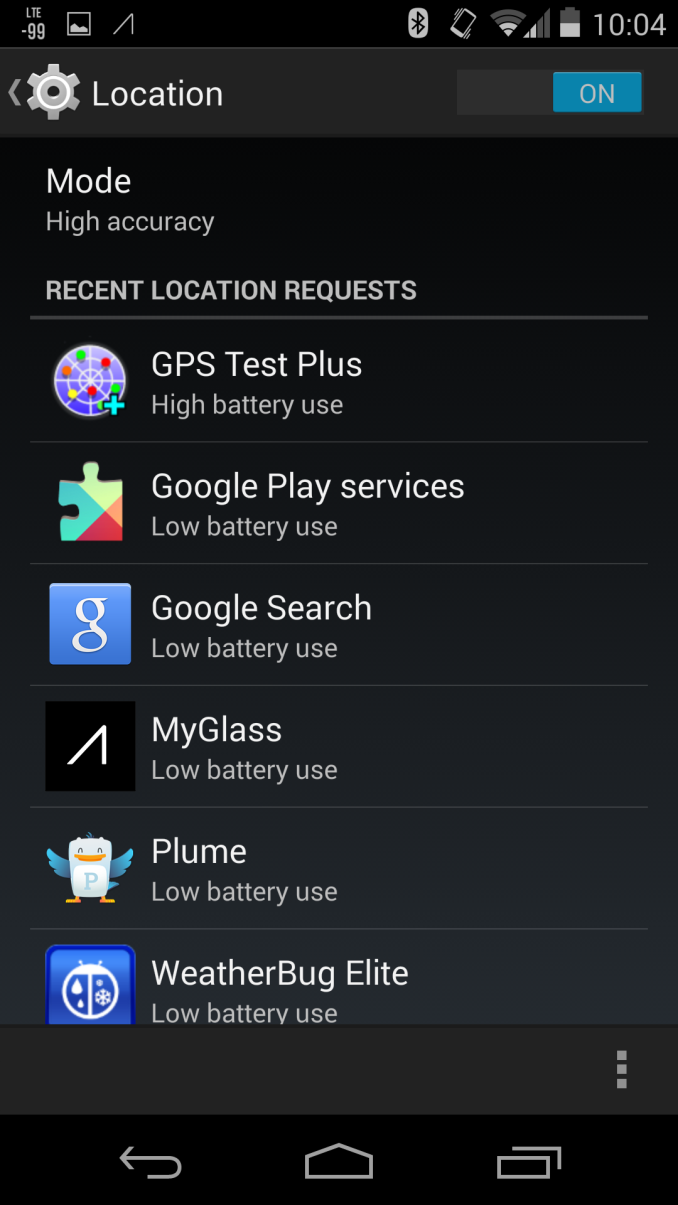
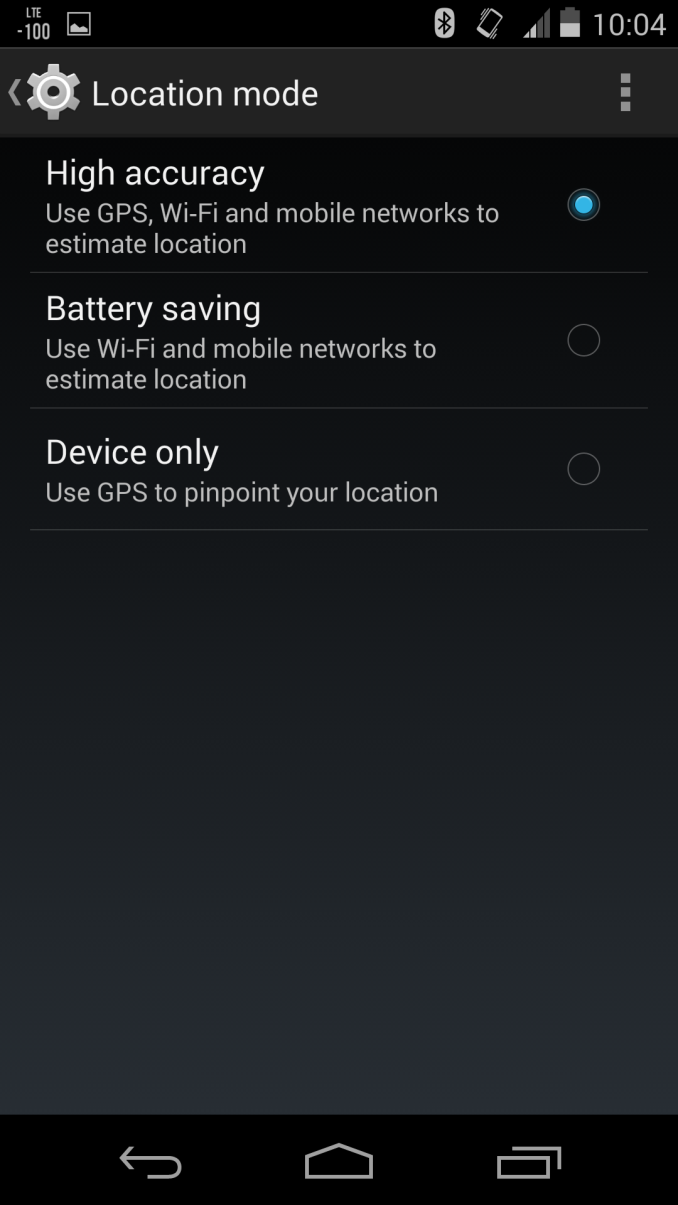
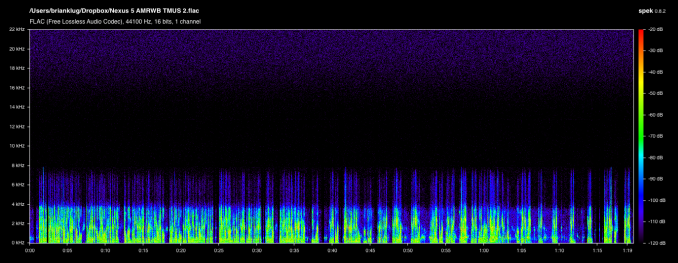








231 Comments
View All Comments
A5 - Thursday, December 5, 2013 - link
You can't just ignore the app count when talking about these devices. No way the 2520 is the best tablet.thunderbird32 - Thursday, December 5, 2013 - link
Even as far as non-Android/iOS tablets go the 2520 isn't the best. I'd much prefer Dell's Venue tablets. Full version of Windows on a Bay Trail SoC is so much more useful than RT on ARM.zoetrope - Thursday, December 5, 2013 - link
Why don't you WinTards troll elsewhere? Enough of the whining and "poor me" attitude. The intertubes is big enough for your ilk, go visit a WP echo chamber like wpcentral.com and keep out of comment sections if you can't stay on topic.Wade_Jensen - Thursday, December 5, 2013 - link
I am thoroughly against insulting people in such a manner, but WinTard is possibly the most hilarious thing since S-gimmick and S-fail.hrrmph - Thursday, December 5, 2013 - link
The greatest tablet? The 2520?Well maybe almost. Nokia specs show the Micro-SD slot to be a crippled version with a 32GB max capacity.
For many people, the low storage capacity makes it DOA, falling down straight out of the gate. There are just too many competing devices that have 64GB capable Micro-SDXC slots.
Of the course, the Nexus 5 is a zero in this category, since it has no slot for Micro-SD of any type.
jimbo2779 - Friday, December 6, 2013 - link
I'm going to ignore the childish name calling for a moment and just say that while I am a big fan of WP and windows tabs I seriously doubt the 2520 is going to be the best tablet going, on paper it has decent hardware and Nokia build quality if great it is still going to be running RT.RT has/had a huge amount of potential but without more app support it will never draw in the crowds and that will in turn not lead to more apps so it is a vicious cycle that I doubt will be changing any time soon. As an OS it is pretty great and you only need to look at some of the fan vids of it online where people are gaming on the tab while watching a video on a TV or vice versa, there is some serious potential to it but without the app support it is likely to stay at potential.
As for WP reviews I do agree that it is very disheartening to not even have some cursory reviews/overviews of them. It really wouldn't be that hard to get a few of the key devices and at least battery test them. At this point a few days of testing would really go a long way to showing how they stack up in terms of battery life.
It is disappointing to not have any real consideration for what is a good phone OS and its devices. Market share is increasing and as it does so will app support and if AT is not careful they could be in a position where WP is more of a serious player (it already is in some parts of the world) and none of the writing staff will have much of an idea about what it is all about.
BoneAT - Thursday, December 5, 2013 - link
Having a whole year to work on the device an two to work on Key Lime Pie, I'm surprised how rushed the Nexus 5 feels. The camera thing is a mess as if there were very, VERY late decisions to include OIS and exclude the new API, and ppl. are reporting wakelocks all over the place.Build quality is extremely worrysome based on drops tests, each ending brutally plus the speaker placement blocks clear sound coming through, boyz @XDA improved it significantly drilling small holes into the plastic underneath.
And then there's the battery - it seems Google understands the flagship concept as far as specs and SW goes, but 4hr SoT on normal use of Google services is NOT flagship level. With a price bump I wonder how they failed to address the Nex4's biggest issue (not much real world improvement based on dozens of N5 XDA users).
Now when you have the camera focus right, when you manually improve the speaker, when you protect it from the smallest drops and when you use all around (excluding all non-KitKat compatible apps), the Nexus 5 is the most successful realization of the Google Phone. These annoyances however makes it a questionable buy, never mind the price tag. The Moto X might just be a better buy considering you get two for one Nexus 5.
THX - Thursday, December 5, 2013 - link
I'm guessing you went with a different phone and are trying to justify your purchase by trashing the shinier, newer, more performant option. :)Maybe I'm missing something but how is the Moto X half the cost of the $350 Nexus 5?
BoneAT - Thursday, December 5, 2013 - link
No criticism, no improvement, buddy. I'm a Nexus user so hit any miss on your cyber bullying attempt, but thx for spotting out my Moto X - Moto G mix-up.THX - Thursday, December 5, 2013 - link
Nexus 4 user? Just sell your phone and get the 5.And I think anyone here would rather have a single fast phone than 2 slow ones, or was there a specific use-case you had in mind?